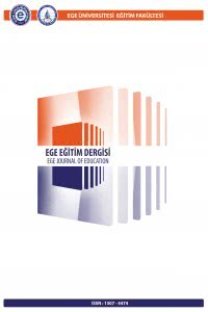İlkokul 4. Sınıf Kesir Öğretiminde Bilgisayar Destekli Öğretimin Öğrencilerin Başarı Düzeyine Etkisi1
The Effectiveness of Computer Assisted Fractions Learning on 4th Grade Students` Achievement Level Submitted by 22.12.2014 Accepted by 26.05.2015
___
- Aktaş, M., Bulut, M. ve Yüksel, T. (2011). The effect of using computer animations and activities about teaching patterns in primary mathematics. The Turkish Online Journal Educational Technology. 10(3), 273-278.
- Camnalbur, M. ve Özdener, N. (2008). İnteraktif akıllı tahtaların, ilköğretim öğrencilerinin matematik başarısı üzerindeki etkileri. Second international conference on innovations in learning for the future. Istanbul University Rectorate Press.
- ESRC (2006). Fractions difficult but crucial in mathematics learning. http://www.tlrp.org/dspace/retrieve/1754/Nunes+RB+13+Fractions+FINAL.pdf adresinden elde edildi.
- Hızal, A. (1989). Bilgisayar eğititmi ve bilgisayar destekli öğretime ġliģkin öğretmen görüģlerinin değerlendirilmesi. Eskişehir: Anadolu Üniversitesi.
- Hoşcan, Y., Yaşar, Ş., Kağnıcıoğlu, C., H., Odabaşı, F., Namlu, A., G., Mutlu, M., E.,Aslan, H. ve Kaymak, İ. (1998). Bilgisayar, Ekişehir: Anadolu Üniversitesi.
- McLeod, R. & Newmarch, B. (2006). Fractions. National Research and Development Center for Adult Literacy and Numeracy.
- https://www.ncetm.org.uk/public/files/257666/fractions_ booklet.pdf adresinden elde edildi.
- Tahir, A., Q. (2005). A Comparative Study Of The Effect Of Use Of Information And Communication Technology In Varied Teaching Approaches On Achievement And Retention Of Students Of Mathematic. (Doktora tezi). Gomal Üniversitesi Eğitim ve Araştırma Merkezi, Pakistan.
- Uşun, S. (2006). Applications and problems of computer assisted education in Turkey. The Turkish Online Journal Educational Technology. 5(4), 11-16.
- Wang, P., Cheng, W., Wang, W. ve Hung, P. (2002, Aralık). An elementary school mathematics dynamic learning system and ıts effects. Sözel bildiri, International conference on computers in education, Auckland.
- Yaylacı, H., S. ve Yaylacı, F. (1999). Eğitim teknolojisi dersinde öğretim materyallerinin geliştirilmesi. AKÜ. Sosyal Bilimler Dergisi, 3, 209-219.
- Yazgan, Y. (2007). 10-11 Yaş Grubundaki Öğrencilerin Kesirleri Kavramaları Üzerine Deneysel Bir Çalışma. YÖK Ulusal Tez Merkezi veri tabanından elde edildi. (Tez no: 220989)
- ISSN: 1307-4474
- Yayın Aralığı: Yılda 3 Sayı
- Başlangıç: 2001
- Yayıncı: Ege Üniversitesi Eğitim Fakültesi
Birey-Çevre Uyumu, Aidiyet Duygusu, Akademik Doyum ve Akademik Başarı Arasındaki İlişkilerin Analizi
Ailelerin Görme Yetersizliği Olan Çocuklarına Yönelik Gelecek Kaygıları
Mustafa SÖZBİLİR, Betül OKCU, Fatih YAZICI
AİLELERİN GÖRME ENGELLİ ÇOCUKLARINA YÖNELİK GELECEK KAYGILARI
Fatih YAZICI, Betül OKCU, Mustafa SÖZBİLİR
4. SINIF KESİR ÖĞRETİMİNDE BİLGİSAYAR DESTEKLİ ÖĞRETİMİN ÖĞRENCİLERİN BAŞARI DÜZEYİNE ETKİSİ
Sınıf Öğretmeni Adaylarının Medya Okur-yazarlık Düzeylerinin İncelenmesi
İlköğretim 6. Sınıf Öğrencilerine Yönelik Cinsel Eğitim Programının Etkililiğinin İncelenmesi
Erteleme: Türleri, Bileşenleri, Demografik Etkenler ve Kültürel Farklılıklar
Akılcı Duygusal Eğitimin Ortaokul Öğrencilerinin Yaşam Doyumları Üzerindeki Etkisi
